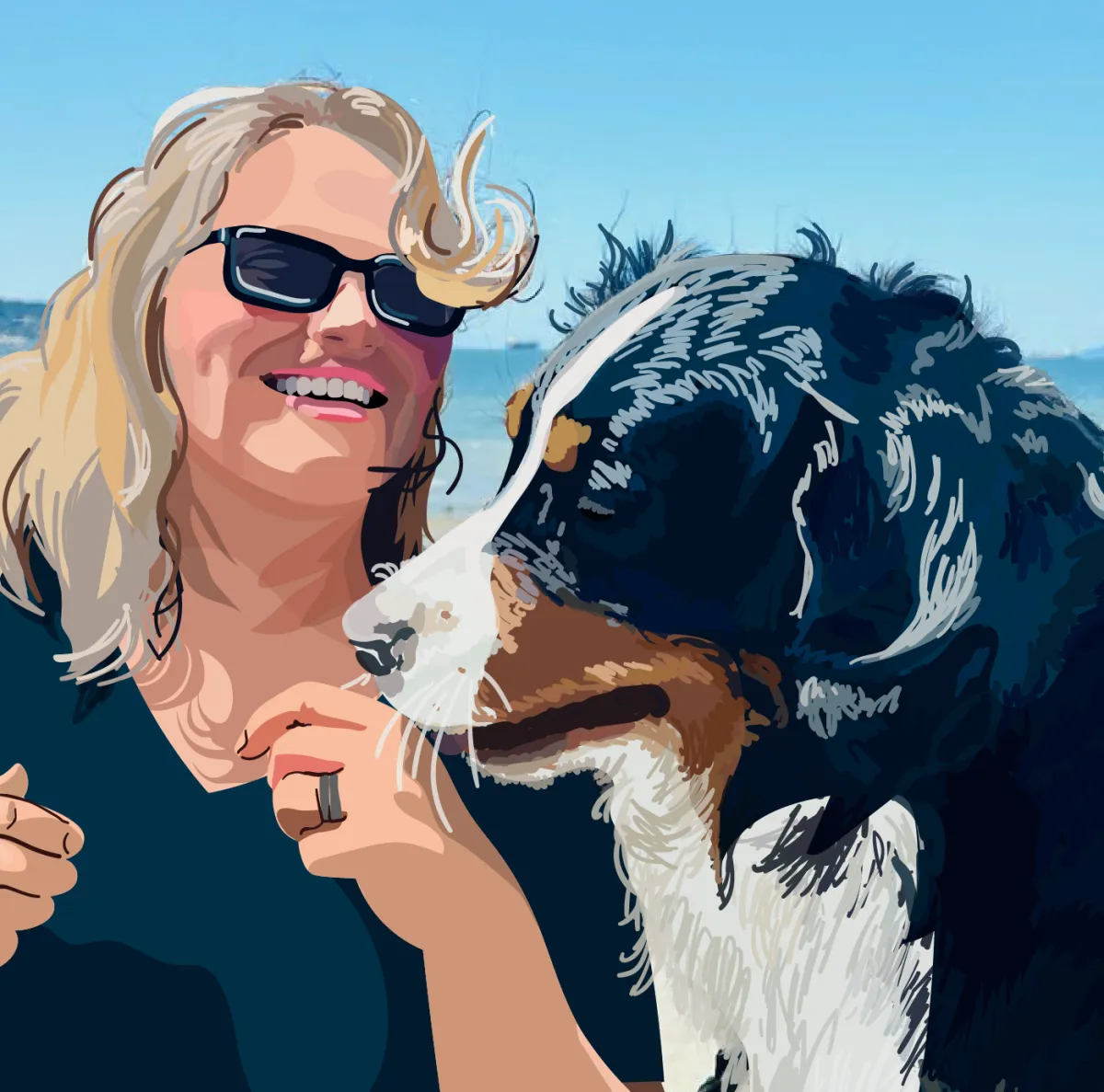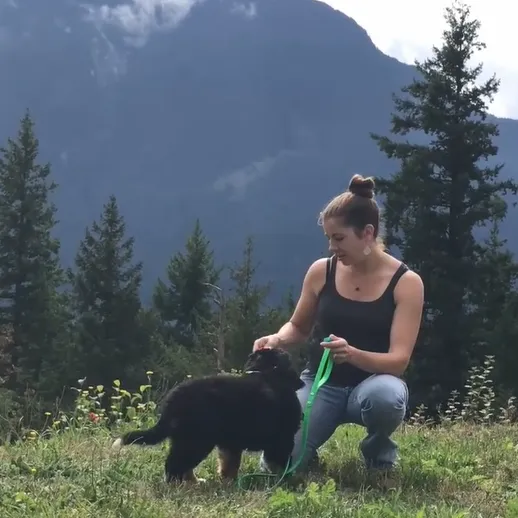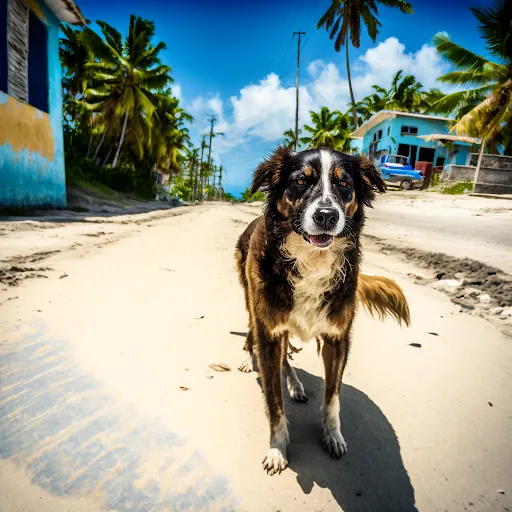

About Us
Since 2011, we’ve combined formal education in psychology, veterinary care, and canine cognition to provide exceptional training.
As an SPCA Accredited AnimalKind organization, we rely on the latest research, while ensuring that our work is rooted in 15,000 years of human-dog connection.
Dogs and humans have evolved together for 20,000 years. They have found food for us, and protected our families and livestock. They have gone to war with us and acted as gentle playmates for our children. They have laid down their lives to save us.
Our lifestyles have changed a lot in the last century, but our need for dogs hasn't. A dog and their owner, when reunited, sync their heart rates within minutes. Just owning a dog decreases heart attack mortality by 30%.
We are designed to live with dogs, but we need to learn how to incorporate them into our chaotic modern lives.
We're here to help your dog become a helpful and contributing member of your modern family.
Forget sit and stay!
At Wag The Dog we can teach dogs to:
Find our phones and keys when we lose them.
Find our children when we lose them!
Put recycling in the blue bin.
Fetch their own leash for walks.
Comfort us when we are sad or stressed.
Close doors and cupboards.
Imitate our actions.
Communicate their needs and thoughts clearly.
Recognize fragile people like children and the elderly and be cautious around them.
Assist us with our disabilities
Accompany us on outings to stores and markets.
Trust us to return home to them when we go out.
Understand simple phrases and two step instructions.

Carol Millman (she/her)
- Lower Mainland
B.Sc, Psychology, Veterinary Technologist, Certified Pet Dog Trainer - Knowledge Assessed (2022), Certified Trick Dog Instructor
Carol lives in Port Coquitlam and works in the Lower Mainland. Her autism gives her a unique perspective which she brings to her work with both dogs and people. Her time working as a veterinary nurse culminated in becoming the Director of Medical Services at a holistic veterinary clinic.
In 2008, Carol was hired as an apprentice Advanced Instructor at Pacific Assistance Dogs Society (PADS). She trained and placed wheelchair assistance dogs, hearing dogs for the Deaf, and facility therapy dogs. She also ran puppy classes and assisted in the daily care of the dogs in training.
PADS still sends people Carol's way when they are looking for private service dog training.

- Currently On Leave -
Amelia Kellum (she/her) - Fraser Valley
B.Sc Canine Studies, Certified Professional Dog Trainer Knowledge/Skills Assessed (2022), Certified Trick Dog Instructor.
Amelia is a certified professional dog trainer with nearly two decades of experience training dogs - including hunting, acting, and assistance dogs such as hearing, therapy, guide, and mobility dogs.
Amelia has learned directly from Bonnie Bergin, pioneer of the disability assistance dog, and is also a graduate of the Ben Kersen and the Wonderdogs professional trainer's program.
She apprenticed at PADS as an instructor and has been training independently since 2010. She now lives in Hope with her family.
What can you achieve
with our help?
Come check out our blog!

Dognapped: The Feral Dogs We 'Rescue'
Dognapped: The Feral Dogs We 'Rescue'
Carol Millman B.Sc, CPDT-KA, CTDI
December 7, 2022
TW: Dogs in pain, suffering, death, guilt.
I used to hate seeing dead dogs on the side of the road. It wasn't a routine occurrence but it happened. Bloated and still, teeth gleaming white in the hot sun, they were one of the most common type of road kill on Curacao, the island where I spent much of my childhood.
I never saw dead goats on the side of the road, even though herds of free-roaming goats were wandering in front of our car on a daily basis. That was for a good reason though - there's good eating on a goat. No one let that go to waste.
Dogs, meanwhile, were left for the authorities to clean up.
Most Canadians never see stray dogs, unless they venture up North or travel to another country. It's important to understand that world-wide, feral dogs are normal.
Estimates place the planet's dog population at upwards of 1 billion dogs. And of that billion, 80% are free-ranging scavengers in heavily populated human areas.
Just like pigeons and cats, dogs are domesticated animals who live around humans far more often than they live with them.
Of the 20% of dogs who have the privilege of being 'owned' by humans, many live in a condition of abuse and neglect. Puppy mills, meat farms (there can be good eating on a dog, too), shelters, and backyard sheds.
The pampered, well-fed dogs of Vancouver are truly the 1% of dogdom.
With health care that is on par with (or, arguably, better than) human medicine, full tummies, and a soft bed to snore on, our dogs are not representative of the average canine.
We Canadians are suckers for free-range, non-GMO dogs and we're willing to pay to get them. Meanwhile, there's an endless supply of them on the streets of practically every major city in the world.
In many ways, a ticket to Canada is the dog version of winning the lottery.
In many more ways, a ticket to Canada is one of the very few expenses of the stray dog trade incurred by less scrupulous "rescue" groups... Many skip steps like spaying and neutering, deworming, and vaccines, and pocket the "adoption fee" as a profit.
While there are many wonderful, dedicated rescues who put a lot of time and effort in selecting, caring for, and finding homes for their rescues, there are many more who are out to sell free dogs off the streets of Thailand, or Iran, or Moscow, or Texas... for a tidy profit.
These organizations tend to deliver the dog to the Canadian family - who paid for the airfare of course - sneezing and emaciated, then disappear from the adopters' lives.
It's like mail order brides, but with dogs.
...And rabies!
Mad Dog's A-Comin'!
North America is considered free of canine rabies nowadays. But in many parts of the world, rabid dogs are the prime source of transmission of rabies to humans.
And rabies is no joke. It's the deadliest virus known to humankind. Once the symptoms take hold, you have a one in a thousand chance of surviving.
The good news is that rabies takes so long to work its way into the brain, that you can be vaccinated AFTER being infected and your immune system will still work faster than the rabies. Post-exposure vaccines are usually quite effective.
Rabies vaccines are cheap, so you'd think it would be no big deal to vaccinate a dog for rabies before packing the frightened mutt into a crate and shipping them to Canada. But for some of the shadier "rescue" (read: stray-dog selling) organizations, I guess that ten bucks is too much profit lost.
There have been multiple cases in Canada and the US of rabid dogs being imported with falsified rabies certificates. Next thing you know, you have a potential health crisis and public health authorities are trying to track down everyone who ever went near that rabid dog.
Canada's sick of dealing with it.
So now these strays are just banned from countries known to have canine rabies.
Sucks for the REAL rescue organizations who genuinely do good work, but as always, bad people ruin everything.
Frankly, I'm Relieved.
This will reduce the number of street dogs coming into Vancouver, and give dog trainers a bit of a rest. It won't completely stem the tide, though. Dogs from the United States and Mexico can still be imported. So can dogs from Curacao, for that matter (they don't have canine rabies either).
But my biggest problem with these imported rescues has nothing to do with rabies or disease (although I am definitely against both of those things).
Free-Roaming Doesn't Mean Homeless
Most Canadians have never lived in a place with feral dogs. In Canada, dogs are pets, so a stray dog is an abandoned pet.
This assumption that an unleashed dog = homeless dog can cause problems even within Canada itself. First Nations reservations have reported family pets being kidnapped by well-meaning "rescuers" who saw a dog roaming freely and assumed it had no family.
We think complete imprisonment of a dog is the norm. It isn't. Not for 90% of the world's dogs, and that includes the ones with families.
In Curacao, pet dogs were generally kept in the yard as protection from thieves. Many dogs got bored of protecting the house and would hop the fence and go for a walk now and then.
I remember walking up the road with my friend Lucy as she called all the neighbourhood dogs by name. They came running from all over at her call, and affably kept us company as we walked.
None of them were leashed. All of them had homes. It's just that in a place where dogs roam free as a matter of course, people don't bother to tie their own up. Identifying them with a collar and tag is enough.
Of the 9,000 or so true "strays" in Curacao, most have a place to call home. It may be a hollow under a bush, or a certain doorstep, or a limestone cave. They may curl up with their mother and their brother, or they may stretch out in the sunshine on their own.
This sound sad, but it's important to understand - it's NORMAL.
Most of the world's dogs have lived free for generations. They are not pets, or even descended from pets. They are a domesticated species that has been re-wilded, just like our city pigeons.
An unowned dog napping in the sun on the sidewalk, stirring occasionally to scratch a flea, is the world's most average dog.
Studies of feral street dogs show that they have a pretty leisurely sort of life, especially in the warmer parts of the world (which these days are MOST parts of the world!)
Most of them fare okay, too. The strays of Curacao were reasonably well fed and in good health most of the time when I lived there. Other than the occasional hit-by-car, I didn't see much to engage my pity for the local dog population.
And yes, I was an inveterate animal lover even then. But I never saw a dog I felt needed me to "rescue" it.
This seems in line with other places, though of course it varies by location.
A study of the Punjab area of India found that in both rural and urban locations, 95% of the free-living dogs they inspected had no obvious medical problems, though they probably needed a deworming or two and would have benefitted from vaccinations.
Fewer than 5% had visible injuries or were underweight.
World-wide, feral dogs live in loosely knit societies. They have complex interpersonal relationships. Some are homebodies with a small close-knit range. Others have the wanderlust and travel between various dog communities. Researchers have found that just by identifying these go-betweens and vaccinating them, we can drastically cut down on the spread of disease among feral dog populations.
Over the generations, successful feral dogs begin to share a similar look. In hot climates it is usually a sandy-coloured coat with black or white regions, big prick ears, and slim faces.
In colder areas, like up North or in Eastern Europe, the dogs are shaggier and develop a more heavy-set, sled-dog/shepherd look.
They are all sound-sensitive, wary of confined spaces, independent, and have big personal space bubbles. These are traits that help them survive.
Feral dogs don't always want a home
For those who have been born and raised in a free-living dog community, and whose mother and grandmother may still be a member of that society -researchers have found that often mothers will help their daughters feed the grandpuppies - being "rescued" must feel much more like being kidnapped.
Feral dogs are very familiar with humans, and even have human friends who they know can be depended on to drop some food scraps now and then, but wary.
A dog who hasn't been played with and raised with humans in puppyhood is not programmed to see humans as potential family. Especially not a dog whose ancestors survived by being alert and wary of humans and their activities. They're genetically primed to watch out for kicking feet and honking cars.
Worst - they've never in their lives been confined by four walls. They've never been constrained by a leash. They've never had a collar around their neck. They've certainly never been told what they must do, or followed the instructions of others.
Nearly everything about pet dog life horrifies them.
For dogs like these, truly feral dogs, a trip to the Pacific Northwest is not a ticket to luxury, but a life-long jail sentence.
Dog trainers in the Pacific Northwest, and no doubt in places like Ontario, too, constantly struggle with the task of helping a feral dog "adjust" to their new life.
The dog wants to live outside all day. The dog is okay being inside with the family but panics if locked in the house alone. The dog fights the leash. The dog growls at intruders. The dog won't let anyone brush their fur or touch their paws. They won't eat their kibble, and break into garbages instead. They want to live their own lives, and have no intention of worshipping their kindly but inflexible captors. If they're from a hot country, like Iran, they hate our cold, rainy climate.
Canadian families who expected a grateful and adoring rescued pet are usually confused by the contrast between what they expected, and what they received.
But what if they're suffering?
Many of the feral dogs shipped to Canada were captured because of a serious illness and injury. A healthy feral dog won't let itself be caught. But once hit by a car, or beaten by an abusive human, or suffering from a illness, they attract the attention of rescue organizations.
I think that this is an act of kindness, certainly. To me, catching and helping sick and injured feral dogs is much like catching and helping sick and injured wildlife. The difference is that an injured hawk or fox is nursed back to health and then released. A feral dog, once in the system, tends to stay in the system... whether they want to or not.
Trap, Treat, Release.
The best way of dealing with feral city dogs, according to researchers and most local animal-welfare societies, is to simply trap the dogs, spay/neuter them, treat medical problems, and release them back into their home environment.
When feral dogs are starving and suffering, it's usually due to overpopulation. If there isn't enough trash and scraps to go around, everyone suffers. Feral dogs have no natural predators except for cars, trucks, and humans with guns. When there are too many of them, they become a public nuisance, often biting people and/or spreading disease... including the deadly rabies.
And we think we have problems with bears!
Many cities have sporadic "dog culls" to reduce uncontrolled feral dog populations.
That includes Canada, by the way.
Trapping, treating, and releasing dogs stops the dogs from adding to the population twice a year, while allowing them to live their born-free life as naturally as possible.
But my rescued stray LOVES his new life!
That's awesome!
As I said in the beginning, for abandoned and neglected pets, a trip to Canada is truly winning the lottery. Rescued dogs have a grateful look in their eye that born-and-raised 1% dogs don't have.
While I believe that rescues dogs are not for everyone, I think it is wonderful to give a home to a dog who has tragically lost the one they were born into.
But there's a difference between a stray dog and a feral dog, and many rescues do not bother to differentiate. When they're advertising the dog, all they can say for sure is that the dog was found on the street, hungry and maybe ill or injured.
Is the dog shy because they are naturally timid? Or because they have no positive experience with humans at all? Is the dog descended from beloved pets? Or descended from wily free-living dogs who spent their whole lives making their own way in the world?
I think that if we really care about the welfare and happiness of dogs, we need to start acknowledging the difference between those two.
For one, a safe and comfortable home is a miracle. For the other, it's a prison.
Rescuing Ethically
If you're determined to rescue a street dog, be sure that the dog you rescue wants to come live with you, and that the organization you're adopting from is actually doing the work of treating and fostering the dogs, and carefully matching them with the right home.
The best way to be sure that the dog you're adopting wants to come home with you is to travel to the destination yourself and look for a dog who adopts YOU.
It happens sometimes. People on vacation in Mexico get adopted by a winsome puppy who doesn't want to let these great folks get away. Someone backpacking through Europe may end up with an unplanned travel companion who has decided to walk onto the train with them and accompany them on their journey.
When a dog adopts YOU, you can be sure they like you and want to be with you, at least. Even so, you should be prepared for a difficult transition to Canada and life on a leash. They won't be like everyone else's dog, that's for sure.
I'll admit it, I fantasize about this myself. What if I went home to Curacao and a cute little puppy just fell in love with me. I'd HAVE to bring it home with me, right?
...Right?
With the new rules about dogs and importation to Canada, I'd face a lot of vet bills and paperwork to do it, so this will probably remain in fantasy-land for me. Plus I'd have to afford to go to the Caribbean on vacation too!
The other option is to select your rescue organization very, VERY, carefully.
Red Flags
Affordable adoption fees.
- it's expensive to rescue a stray properly. If the adoption fee is low, then chances are corners were cut.
Feral dog is over 2 years of age
- If it's hard for young dogs to adjust to their new life, it's virtually impossible for mature dogs who are set in their ways. A change of climate and culture is stressful on an adult dog with a traumatic past.
No video or pictures of dog in home environment
- If the dog has been fostered in a home to see how it handles being indoors, the rescue should be able to show you videos of the dog interacting with people and other dogs in that foster environment.
Dog flies directly to you.
-If they want you to meet the dog at the airport, that's a bad sign. They should have a local foster who checks the dog and supports the placement of the dog in your home.
Minimal screening process.
- They should be interested in you, your lifestyle, your experience with dogs, and they should be checking your expectations. Good rescues want successful placements and won't place abused or shy feral dogs in an inexperienced home with children.
Green Flags
High adoption fees
- Vet care is expensive. A rescued stray will have parasites, infections, and injuries to deal with. That costs money.
The dog is a puppy.
- feral dogs should be socialized to human households before 16 weeks in order to make successful pets in Canada. Pet dogs can be adopted at any age, of course.
Lots of footage or live-video possibilities showing the dog in a home environment.
- you should be able to see how the dog handles being indoors, interactions with children and adults, and with other dogs.
The rescue imports the dog themselves under their own name, and puts it in a local foster home first.
- The transition to your home should be done carefully. They usually fly the dogs with human escorts.
Heavy screening process
- The rescue wants to be sure that you know what you're taking on: Have you had rescues before? Are you aware of the challenges of adopting a feral dog? How do you plan to handle difficulties if they come up? Do you have references?
By paying attention to where the dog comes from, how the ones to be shipped to Canada are chosen, and how much care the organization puts into ensuring that the dog is happy and set up for success, you can feel more sure that you are, indeed, rescuing the dog, and not kidnapping them from their own life.
PS: here's a rescue in Curacao that has plenty of green flags. They have pictures of cute puppies...
Just, y'know. In case.

We work on land which was taken from the nations who had lived here for thousands of years. They are still here and they are still waiting patiently for us to stop being jerks about it.
© 2024 Copyright Wag The Dog Training
All Rights Reserved




